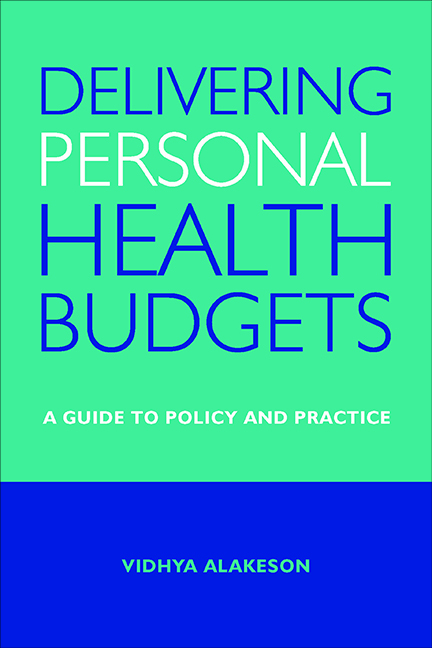Book contents
- Frontmatter
- Contents
- List of tables and figures
- Acknowledgements
- Prologue: Stephen’s story
- Introduction
- Section 1 Introducing personal health budgets
- Section 2 Implementing personal health budgets
- Section 3 Personal health budgets and organisational change in the NHS
- Conclusion
- Epilogue: Jonathan’s story
- References
- Index
six - The personal health budget process
Published online by Cambridge University Press: 03 February 2022
- Frontmatter
- Contents
- List of tables and figures
- Acknowledgements
- Prologue: Stephen’s story
- Introduction
- Section 1 Introducing personal health budgets
- Section 2 Implementing personal health budgets
- Section 3 Personal health budgets and organisational change in the NHS
- Conclusion
- Epilogue: Jonathan’s story
- References
- Index
Summary
We saw in Section 1 that effective implementation has been critical in shaping positive outcomes for users of personal budgets in social care. Evidence from the PHB pilot reaches the same conclusion: implementation can make the difference between a positive and a negative experience for PHB holders and their families. The PHB evaluation highlights problems in some pilot sites with individuals not knowing how their budget was calculated or the value of their budget; some examples of inadequate support for planning; and a lack of transparency around the spending rules, leading to arbitrary approval or denial decisions and delays (Irvine at al, 2011; Davidson et al, 2012). Given its central importance, this section focuses on implementation and discusses the three types of infrastructure that are needed for PHBs in each of the following chapters: a system for allocating resources to individuals; a system of support for PHB holders which includes care planning; and the infrastructure for money management and monitoring. This chapter presents an overview of the PHB process. For anyone who has worked with personal budgets in social care, the process will feel familiar, but there are important differences given the clinical dimension to a PHB.
The seven-step personal health budget process
There are seven basic steps in the PHB process. These are common regardless of the condition for which a PHB is offered and are set out in Figure 6.1.
Step 1: Engaging individuals with PHBs. The first step is to engage potential PHB holders with the concept of a PHB, ensuring that they get good information and are able to make an informed decision about whether to take up the offer of a PHB. The decision to take up a PHB should always be voluntary, and it is absolutely critical that each person makes an active choice to have one as this is the start of the culture shift for the individual – from passive recipient of care to active participant. If the person is not engaged and informed at this stage, they will be a ‘passenger’ throughout the process and the PHB is less likely to succeed. Interviews with PHB holders three months after joining the programme found people still struggling with the concept of personalisation as they were used to professionals telling them what was best (Irvine et al, 2011).
- Type
- Chapter
- Information
- Delivering Personal Health BudgetsA Guide to Policy and Practice, pp. 73 - 80Publisher: Bristol University PressPrint publication year: 2014

